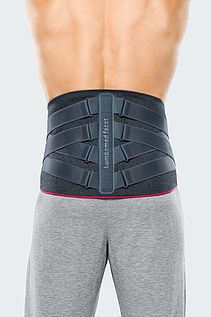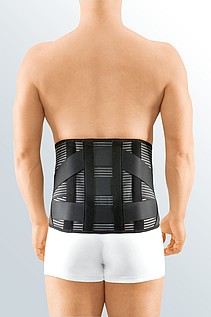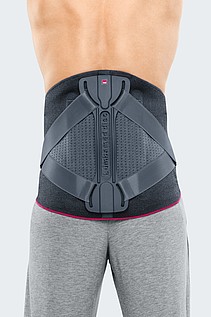Back orthoses from medi: Stabilising aids for back problems and osteoporosis
medi offers patients high-quality back orthoses for indication-based therapy. The products can support the healing process and relieve pain. They impress with their high wearing comfort and easy handling.
If medically necessary, the doctor can prescribe a back orthosis. In most cases, your health insurance will cover the costs. Your attending physician will tell you when and for how long you should wear your orthosis.
-

Lumbamed® sacro Modular pelvic support for stabilisation with massage pads
Size- I
- II
- III
- IV
- V
- Silver
-

Lumbamed® maternity Lumbar support for stabilisation of the lumbar spine during pregnancy
Size- I
- II
- III
- Grey
-

Lumbamed® plus Lumbar support with massage pad for stabilisation
Size- I
- II
- III
- IV
- V
- Silver
-

Lumbamed® plus E⁺motion® Performance lumbar spine orthosis
SizeNew- 1
- 2
- 3
- 4
- 5
- Black geometric
-

Lumbamed® active Lumbar support for stabilisation of the lumbar spine
Size- I
- II
- III
- IV
- V
- Black
-

Lumbamed® facet Lumbar support for relief of the facet joints
Size- I
- II
- III
- IV
- V
- VI
- Silver
-

Lumbamed® stabil Lumbar support for relief of the lumbar spine
Size- I
- II
- III
- IV
- V
- VI
- Black
-

Lumbamed® basic Brace for stabilisation of the lumbar spine
Size- I
- II
- III
- IV
- V
- Silver
-

Lumbamed® disc Modular lumbar support for relief and mobilisation
Size- I
- II
- III
- IV
- V
- VI
- Silver
-

Spinomed® Back orthosis for vertebral extension in osteoporosis
Size- XS
- S
- M
- L
- XL
- XXL
- Grey
-

Spinomed® II Back orthosis
Size- XS
- S
- M
- L
- Silver
-

Spinomed® active Back orthosis for vertebral extension for active relief
Colours- Black
- Champagne
How back splints work
Back splints can support and relieve various complaints, for example in the case of deep-seated back pain, lumbalgia, facet joint arthrosis, muscle tension or osteoporosis. They are able to straighten and stabilise the back.
Back stabilisation and improvement of muscle strength with lumbar orthoses
Various stabilising back orthoses are used to accompany physiotherapy, heat treatments, massages or manual therapy. A study shows that lumbar spine stabilising orthoses relieve pain, as well as improve mobility and muscle strength.1
Spinal straightening back orthoses for osteoporosis
The DVO guideline recommends the use of spine-straightening orthoses such as the Spinomed.2,3 Thanks to its shoulder strap system and the back splint, it constantly reminds osteoporosis patients to actively straighten themselves into the correct posture. This process is called biofeedback. As a result, the muscles are sustainably strengthened. In addition, the more upright posture facilitates breathing and relieves pain. The reduced tendency to sway ensures that osteoporosis patients can stand more securely.
Sources
1 Thomas R et al. Der Einfluss von Lumbalorthesen auf Schmerzlinderung, Muskelkraft und Statik. Orthopädie-Technik 2013;12:64–69.
2 Pfeifer M et al. Am J Phys Med Rehabil 2011;90(10):805–815.
3 Pfeifer M et al. Am J Phys Med Rehabil 2004;83(3):177–186. 3 DVO. Prophylaxe, Diagnostik und Therapie der Osteoporose bei postmenopausalen Frauen und bei Männern. 2017; S. 196-200. Online veröffentlicht unter: www.dv-osteologie.org/dvo_leitlinien/dvo-leitlinie-2017 (Letzter Zugriff 07.11.2018).

